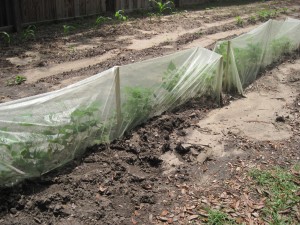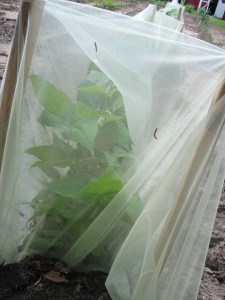There are many reasons to cage your growing plants. Caging keeps insects out which minimizes damage from caterpillars, leafhoppers, vine borers, aphids, and more. Caging also keeps your seeds pure and true-to-type. For example, if you are growing 3 different types of beans this year that you intend to keep seed from, they can cross via bee pollen transfer. Although your plants will grow as they should this season, the seeds you collect from them will not be pure the following year.
Please note that some plants require pollination. In order for a squash to grow, an insect must visit the male and female flowers on your plant. If the blooms were caged no insects could reach the flowers to complete this process and the plants would bear no fruit. Caging is still very beneficial to keep insect pollinating plants pure, however they must be uncaged, pollinated by hand, and re-caged. When this process is used it is important to mark each of the female flowers you pollinate (we use surveyor tape gently tied under the ovary so we know which veggies are pure to keep for seed). Generally, it is easier to bag individual blooms on a plant like this, instead of the cage method. Bags made from organza, spun polyester, or pantyhose are ideal for this purpose and can be removed as soon as the bloom closes.
Plants that are self-pollinating like most bean and pea varieties do not require insects, as they pollinate themselves as the name implies. These varieties can be caged to ensure pure seed.
Caging is fairly simple. Window screen, organza, and spun polyester are popular choices of material. In the picture above I pounded wood stakes 1″ into the ground and then laid organza over that, burying all edges firmly in the dirt to ensure that no bugs could enter. The organza will be removed as pods develop and are ready to eat or we will allow them to dry on for seed collection.
It is very important that no bugs are present before you cage your plants. The cage will protect insects from any outside predators and create a perfect environment for them to thrive on your plants.
Cages are great for organic growers who do not wish to use pesticides. Notice the caterpillars unable to get into my organza cage in the picture below…
A cheaper and better alternative to organza is spun polyester. I happened to have some organza on hand for this project. A great site for spun polyester is… http://www.gardensalive.com/product.asp?pn=82274 . The material is hardier than what it appears in the picture and water can penetrate it. It also provides great air circulation and does not hold heat in. Right now they have a 20.00 of of purchases totalling 40.00 or more. You can see the ad for this on the home page in the right-hand corner.
NOTE: Organza does retain some moisture. This was my first year using it over beans and the bean sections that the orgranza covered became TOO damp.

